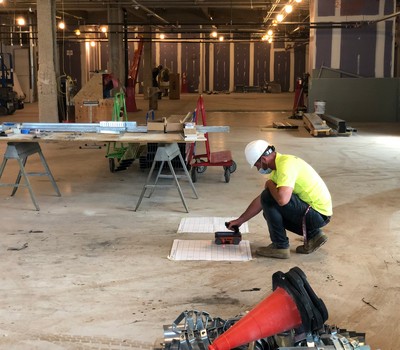Precision and Precision in Concrete Scanning Solutions
Past the Surface Area: Leveraging Advanced Concrete Scanning Techniques for Unmatched Accuracy and Insight
Advanced concrete scanning strategies have arised as vital devices in this quest, supplying a glance under the surface area to introduce a world of critical insights. By utilizing innovative innovations, experts can discover anomalies, analyze the condition of concrete structures, and make notified choices that shape the program of projects.
Relevance of Advanced Concrete Scanning
The relevance of utilizing innovative concrete scanning techniques exists in the unparalleled accuracy they use for finding sub-surface abnormalities and ensuring structural honesty. By employing sophisticated technologies such as ground-penetrating radar (GPR), electromagnetic induction, and progressed finder imaging, building specialists can dive underneath the surface area of concrete structures with a level of accuracy that much exceeds traditional evaluation approaches. Concrete Scanning. These methods enable the recognition of covert threats like rebar rust, gaps, channels, or post-tension cords that could compromise the security and safety of a structure in time
In addition, progressed concrete scanning gives invaluable understandings into the total problem of a concrete element without the demand for intrusive steps, decreasing the threat of triggering damages throughout the assessment procedure. The capability to determine the precise place and deepness of potential problems enables targeted repair services and upkeep, inevitably lengthening the life expectancy of the structure and maximizing its efficiency. Essentially, the significance of advanced concrete scanning can not be overstated in the world of construction and framework maintenance, where accuracy and reliability are extremely important.
Kinds Of Cutting-Edge Technologies

Anomalies and Issue Detection

Along with GPR, concrete scanning techniques like thermography and impact-echo screening are likewise reliable in spotting anomalies and flaws. Thermography utilizes infrared technology to determine variants in surface area temperature level, indicating potential locations of worry such as delamination or dampness ingress. On the other hand, impact-echo screening involves evaluating acoustic feedbacks to detect gaps, cracks, and other problems within the concrete. By leveraging these innovative strategies, professionals can proactively attend to architectural problems, ensuring the longevity and safety of concrete frameworks.
Assessing Concrete Condition
Just how can designers properly review the condition of concrete frameworks to guarantee their long life and safety? Examining the concrete problem is an important facet of keeping framework honesty. Numerous sophisticated concrete scanning strategies are utilized for this purpose. Ground-penetrating radar (GPR) is frequently utilized to examine the internal framework of concrete, spotting voids, fractures, and other abnormalities that might endanger its strength. In addition, impact-echo screening can offer understandings right into the thickness and honesty of concrete components. Ultrasonic pulse speed testing is another beneficial technique for examining concrete quality by gauging the rate of acoustic waves with my link the material.
Furthermore, aesthetic inspection stays an essential component of concrete condition analysis. Designers visually analyze the surface for indicators of damage, such as spalling, breaking, or discoloration. Incorporating non-destructive screening approaches with visual examinations enables a detailed examination of concrete problem, allowing designers to identify potential concerns early on and implement prompt upkeep or repair work. By leveraging these sophisticated techniques, designers can make certain the lasting resilience and safety and security of concrete structures.
Enhancing Decision-Making Processes
In the world of facilities management, enhancing decision-making processes is imperative for ensuring the efficient upkeep and long life of concrete structures. Boosted decision-making procedures in concrete administration include making use of advanced scanning strategies to gather comprehensive data on the problem of structures. By leveraging innovations such as ground-penetrating radar and 3D imaging, stakeholders can make enlightened choices regarding repair service, support, or substitute strategies.
These progressed scanning methods supply invaluable insights you can try here right into the inner make-up of concrete, recognizing potential issues such as gaps, cracks, or deterioration that may not show up on the surface area. This degree of thorough details enables for proactive maintenance preparation, decreasing the danger of structural failures and increasing the overall life-span of concrete frameworks.
Additionally, by integrating electronic documents and evaluation devices into the decision-making process, stakeholders can track the advancement of concrete problems over time, enabling anticipating maintenance techniques and maximizing resource appropriation. Ultimately, the integration of advanced concrete scanning techniques boosts decision-making processes by supplying unrivaled precision, insight, and effectiveness in framework management.
Verdict
In conclusion, progressed concrete scanning techniques offer unequaled accuracy and understanding in finding anomalies, problems, and analyzing the problem of concrete frameworks. By leveraging innovative technologies, decision-making processes can be boosted, bring about more informed and effective solutions Source for preserving and fixing concrete framework. These strategies play a critical role in making sure the safety and security and long life of concrete frameworks, making them a crucial device in the field of building and construction and engineering.
Furthermore, progressed concrete scanning provides indispensable insights into the overall problem of a concrete element without the requirement for invasive measures, lessening the risk of triggering damages throughout the assessment procedure - Concrete Scanning. One more ingenious technology is 3D X-ray scanning, which supplies in-depth photos of the inner structure of concrete, supplying valuable info without the requirement for devastating screening. Additionally, Concrete Cover Meters are made use of to measure the thickness of concrete cover over support bars properly. Improved decision-making procedures in concrete management include making use of sophisticated scanning strategies to collect thorough information on the condition of frameworks.In verdict, advanced concrete scanning techniques use unmatched precision and insight in finding anomalies, defects, and evaluating the condition of concrete frameworks